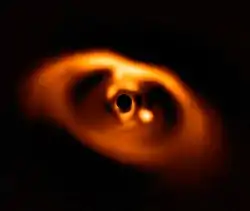Kepler-13
Kepler-13 or KOI-13 is a stellar triple star system consisting of Kepler-13A, around which an orbiting hot Jupiter exoplanet was discovered with the Kepler spacecraft in 2011, and Kepler-13B a common proper motion companion star which has an additional star orbiting it.[6]
| Observation data Epoch J2000.0 Equinox J2000.0 | |
|---|---|
| Constellation | Lyra[1] |
| Right ascension | 19h 07m 53.1397s[2] |
| Declination | 46° 52′ 05.931″[2] |
| Apparent magnitude (V) | 9.95[3] (KOI-13A=10.33[4]) |
| Characteristics | |
| Spectral type | A0 |
| Astrometry | |
| Proper motion (μ) | RA: −4.401±0.187[2] mas/yr Dec.: −15.780±0.237[2] mas/yr |
| Parallax (π) | 1.9053 ± 0.1051[2] mas |
| Distance | 1,710 ± 90 ly (520 ± 30 pc) |
| Details[5] | |
| Kepler-13A | |
| Mass | 1.72±0.10 M☉ |
| Radius | 1.71±0.04 R☉ |
| Surface gravity (log g) | 4.2±0.5 cgs |
| Temperature | 7650±250 K |
| Metallicity [Fe/H] | 0.2±0.2 dex |
| Rotational velocity (v sin i) | 78±15 km/s |
| Age | 0.5±0.1 Gyr |
| Kepler-13B | |
| Mass | 1.68±0.10 M☉ |
| Radius | 1.68±0.04 R☉ |
| Surface gravity (log g) | 4.2±0.5 cgs |
| Temperature | 7530±250 K |
| Metallicity [Fe/H] | 0.2±0.2 dex |
| Rotational velocity (v sin i) | 69±13 km/s |
| Age | 0.5±0.1 Gyr |
| Other designations | |
| Database references | |
| SIMBAD | data |
Stellar system
The multiple nature of the system was discovered in 1904 by Robert Grant Aitken at Lick Observatory. He measured a separation between the A and B components of approximately one arc second and position angle of 281.3° with the 36" James Lick telescope.[7] The position of the two visual components of the system relative to each other has remained constant since 1904.[8] Radial velocity measurements taken with the SOPHIE échelle spectrograph at the Haute-Provence Observatory revealed an additional companion orbiting Kepler-13B. This companion has a mass of between 0.4 and 1 times that of the Sun and orbits with a period of 65.831 days with an eccentricity of 0.52[6]
Planetary system
Kepler-13 was identified as one of 1235 planetary candidates with transit-like signatures in the first four months of Kepler data.[9] It was confirmed as a planet by measuring the Doppler beaming effect on the Kepler light curve.[10] The planet that has been confirmed, having a radius of between 1.5 and 2.6 RJ, is also one of the largest known exoplanets.
The planet is likely to be tidally locked to the parent star. In 2015, the planetary nightside temperature was estimated to be equal to 2394±251 K.[11]
The study in 2012, utilizing a Rossiter–McLaughlin effect, have determined the planetary orbit is mildly misaligned with the equatorial plane of the star, misalignment equal to 24±4°.[12]
| Companion (in order from star) |
Mass | Semimajor axis (AU) |
Orbital period (days) |
Eccentricity | Inclination | Radius |
|---|---|---|---|---|---|---|
| b | 9.28±0.16 MJ | 0.03641±0.00087 | 1.763588±0.000001 | 0.00064+0.00012 −0.00016 |
86.770+0.048 −0.052° |
2.216±0.087 RJ |
References
- Roman, Nancy G. (1987). "Identification of a Constellation From a Position". Publications of the Astronomical Society of the Pacific. 99 (617): 695–699. Bibcode:1987PASP...99..695R. doi:10.1086/132034. Vizier query form
- Brown, A. G. A.; et al. (Gaia collaboration) (August 2018). "Gaia Data Release 2: Summary of the contents and survey properties". Astronomy & Astrophysics. 616. A1. arXiv:1804.09365. Bibcode:2018A&A...616A...1G. doi:10.1051/0004-6361/201833051. Gaia DR2 record for this source at VizieR.
- "Kepler-13". SIMBAD. Centre de données astronomiques de Strasbourg. Retrieved 2018-01-07.
- Howarth, Ian D.; Morello, Giuseppe (2017). "Rapid rotators revisited: Absolute dimensions of KOI-13". Monthly Notices of the Royal Astronomical Society. 470 (1): 932–939. arXiv:1705.07302. Bibcode:2017MNRAS.470..932H. doi:10.1093/mnras/stx1260. S2CID 31123194.
- Shporer, Avi; et al. (2014). "Atmospheric Characterization of the Hot Jupiter Kepler-13Ab". The Astrophysical Journal. 788 (1). 92. arXiv:1403.6831. Bibcode:2014ApJ...788...92S. doi:10.1088/0004-637X/788/1/92.
- Santerne, A.; et al. (2012). "SOPHIE velocimetry of Kepler transit candidates. VI. An additional companion in the KOI-13 system". Astronomy and Astrophysics. 544. L12. arXiv:1207.1715. Bibcode:2012A&A...544L..12S. doi:10.1051/0004-6361/201219899. S2CID 118482346.
- Aitken, Robert Grant (1904). "Measures of one hundred fifty-five new double stars". Lick Observatory Bulletin. 3: 6–18. Bibcode:1904LicOB...3....6A. doi:10.5479/ADS/bib/1904LicOB.3.6A.
- Szabó, Gy. M.; et al. (2011). "Asymmetric Transit Curves As Indication of Orbital Obliquity: Clues from the Late-Type Dwarf Companion in Koi-13". The Astrophysical Journal Letters. 736 (1). L4. arXiv:1105.2524. Bibcode:2011ApJ...736L...4S. doi:10.1088/2041-8205/736/1/L4.
- Borucki, William J.; et al. (2011). "Characteristics of Planetary Candidates Observed by Kepler. II. Analysis of the First Four Months of Data". The Astrophysical Journal. 736 (1). 19. arXiv:1102.0541. Bibcode:2011ApJ...736...19B. doi:10.1088/0004-637X/736/1/19.
- Shporer, Avi; et al. (2011). "Detection of Koi-13.01 Using the Photometric Orbit". The Astronomical Journal. 142 (6). 195. arXiv:1110.3510. Bibcode:2011AJ....142..195S. doi:10.1088/0004-6256/142/6/195.
- A Comprehensive Study of Kepler Phase Curves and Secondary Eclipses:Temperatures and Albedos of Confirmed Kepler Giant Planets
- Albrecht, Simon; Winn, Joshua N.; Johnson, John A.; Howard, Andrew W.; Marcy, Geoffrey W.; Butler, R. Paul; Arriagada, Pamela; Crane, Jeffrey D.; Shectman, Stephen A.; Thompson, Ian B.; Hirano, Teruyuki; Bakos, Gaspar; Hartman, Joel D. (2012), "Obliquities of Hot Jupiter host stars: Evidence for tidal interactions and primordial misalignments", The Astrophysical Journal, 757: 18, arXiv:1206.6105, doi:10.1088/0004-637X/757/1/18, S2CID 17174530
- Esteves, Lisa J.; Mooij, Ernst J. W. De; Jayawardhana, Ray (2015). "Changing Phases of Alien Worlds: Probing Atmospheres Of Kepler planets with High-Precision Photometry". The Astrophysical Journal. 804 (2). 150. arXiv:1407.2245. Bibcode:2015ApJ...804..150E. doi:10.1088/0004-637X/804/2/150.
